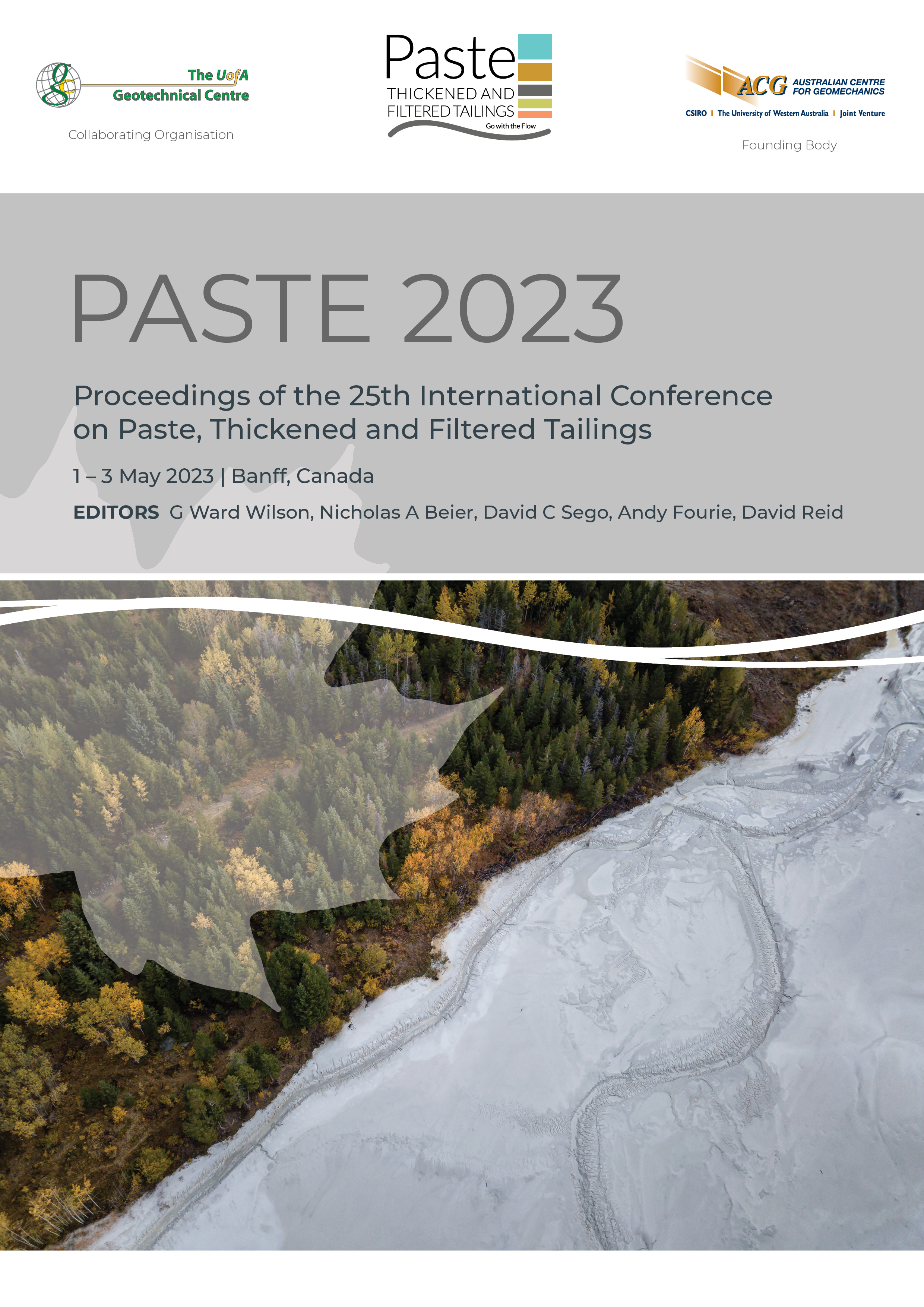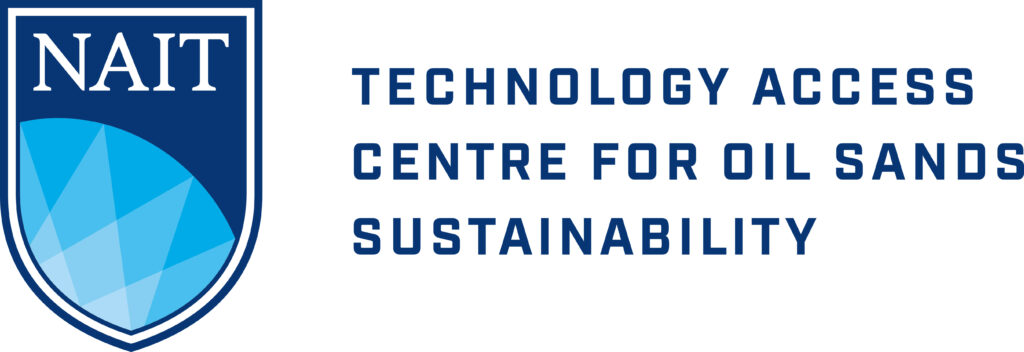How to compact filtered tailings

|
Authors: McKenna, G |
DOI https://doi.org/10.36487/ACG_repo/2355_33
Cite As:
McKenna, G 2023, 'How to compact filtered tailings', in GW Wilson, NA Beier, DC Sego, AB Fourie & D Reid (eds), Paste 2023: Proceedings of the 25th International Conference on Paste, Thickened and Filtered Tailings, Australian Centre for Geomechanics, Perth, pp. 440-454, https://doi.org/10.36487/ACG_repo/2355_33
Abstract:
To control the risk of static or dynamic liquefaction, filtered tailings stacks are typically designed to be compacted and to remain unsaturated. In theory, compacting filtered tailings should be easy, since mines tend to produce a consistent, well-graded sandy silt or silty sand tailings. The filter presses are designed to produce tailings with a geotechnical moisture content within a narrow range; modest-sized equipment can compact the tailings in thin lifts; and traditional earthworks quality control methods are common and readily available. In practice, however, filtered tailings and mine owners often discover that the learning curve associated with compacting filtered tailings can be steeper than expected. The filter plant will typically produce tailings that are somewhat wet of the standard Proctor optimum moisture content, making compaction difficult. If not protected, tailings at the loadout can absorb water or freeze. The tailings stack must be kept graded to promote runoff. In some climates, evaporation may be insufficient for drying; in others, snow, ice, and freezing conditions present a challenge. At some mines, the tailings liquefy under cyclic loading by dozers, trucks, or compactors as they are being placed. Choosing a tailings field-density specification is not straightforward, especially where high stresses at the base of the stack can increase the risk of static or dynamic liquefaction. Method specs for compaction may be employed, but can be unreliable under certain conditions. A nuclear densometer often does not provide accurate readings of the density of some tailings, particularly those with elevated levels of metals. This paper presents practical, hard-won lessons and solutions from the field to aid in the design, operation, and closure of filtered tailings facilities based on firsthand experience in Canada and interviews with operators around the world, lessons that can help shorten the learning curve for new and existing filter stack operations.
Keywords: compaction, filtered tailings, earthworks, geotechnical, landform design, density, liquefaction, moisture, tailings stack, quality assurance, quality control.
References:
Access Consulting Group (Access) 2003, Examination of revegetation methodologies for dry stack tailings in northern environments, Consultant’s report for the Mining Environmental Research Group, Government of Yukon, Access Consulting Group, 35 p.
Andrews, J, Crouse, P, Henderson, M, McKenna, G, Slingerland, N, Williams, D & Fine Morrison, K 2022, ‘Chapter 15: Closure planning and landform design’, in K Finke Morrison (ed.), SME Tailings Management Handbook: A Life Cycle Approach, Society for Mining, Metallurgy & Exploration, Englewood, 1004 p.
ASTM 2021, Standard test methods for laboratory compaction characteristics of soil using standard effort, ASTM D698–12(2021), ASTM International (Standard Proctor Dry Density).
Boldt CMK 1985, Compaction criteria for metal and nonmetal tailings, Bureau of Mines Report of Investigations 8921, 32 p.
Burnett, A & McKenna, G 2022, ‘Celebrating 50 years: the Syncrude Geotechnical Review Board’, presented at CDA Canadian Dam Association Conference, St Johns, 20 p.
Cameron, C, Mimura, W, Fong, V & Lussier, L 2001, ‘Detailed construction procedures and considerations in Syncrude’s quasi-homogeneous earthfill dams’, Proceedings of the 54th Canadian Geotechnical Conference, Calgary, pp. 235–243.
Condon, PD & Lear, KG 2006, ‘Geochemical and geotechnical characteristics of filter-pressed tailings at the Greens Creek Mine, Admiralty Island, Alaska’, Proceedings of the 7th International Conference on Acid Rock Drainage (ICARD), American Society of Mining and Reclamation (ASMR), Lexington, pp. 350–363.
Crystal, C, Hore, C & Ezama, I 2018, ‘Filter-pressed dry stacking: design considerations based on practical experience’, Proceedings of the 22nd International Conference on Tailings and Mine Waste 2018, Colorado State University, pp. 209–220.
CTMC 2012, Oil sands tailings technology deployment roadmap: Project Report – Volume 2, Component 1 Results, Consortium of Tailings Management Consultants, Consultants report to Alberta Innovates – Energy and Environment Solutions, June 22, 2012, 112 p.
Davies, M 2011, ‘Filtered dry stacked tailings – the fundamentals’, Proceedings of the Tailings and Mine Waste Conference 2011, University of British Columbia, 9 p.
Davies, M, Mayhew, K & Anderson, C 2022, ‘Chapter 6: Dewatered tailings’, in K Finke Morrison (ed.), SME Tailings Management Handbook: a Life Cycle Approach, Society for Mining, Metallurgy & Exploration, Englewood, 1004 p.
Davies, MP & Rice, S 2001, ‘Alternative to conventional tailing management – ‘dry stack’ filtered tailings’, Proceedings of the Tailings and Mine Waste Conference 2001, AA Balkema Publishers, 10 p.
Emerman, SH 2021, Evaluation of the tailings storage facility for the proposed Savannah Lithium Barroso Mine, Northern Portugal, Consultant’s report to Povo e Natureza do Barroso dated June 29, Malach Consulting, Spanish Fork, UT, 43 p.
Fell, RF, MacGregor, P, Stapledon, D, Bell, G & Foster, M 2014, Geotechnical Engineering of Dams, 2nd edn, CRC Press, London, 1382 p.
Hore, C 2020, ‘A step change in dry stack tailings – our challenge’, Austmine Water & Waste Management eBook, 3 p.
ICOLD 2022, Tailings Dam Safety, Draft dated November 16, 2022, Committee L Tailings Dams and Waste Lagoons, International Commission on Large Dams, Paris, 210 p.
INAP 2017, Global Cover Systems Design – Technical Guidance Document, International Network for Acid Prevention, Consultant’s report by O’Kane Consultants, Saskatoon, 216 p.
LDI 2021, ‘Mining with the end in mind: Landform design for sustainable mining’, Position Paper 2021–01, March 2021, Landform Design Institute, Delta, BC, Canada, 78 p.
Lemieux, N, Leahy, D, St-Laurent, J-F & James, M 2011, ‘A case study: The seismic stability of an upstream-raised tailings impoundment (part i)’, Pan-AM CGS Geotechnical Conference, 8 p.
Liu, C & Evett, JB 2009, Soil Properties: Testing, Measurement and Evaluation, 6th edn, Pearson Prentice Hall, Columbus, 440 p.
Lupo, J & Hall, J 2010 ‘Dry stack tailings – design considerations’, Proceedings Fourteenth International Conference on Tailings and Mine Waste, A.A. Balkema, Rotterdam, pp. 327–334.
MEND 2012, Cold regions cover system design technical guidance document, MEND Report 1.61.5c, Consultant’s report prepared by O’Kane Consultants for Mine Environment Neutral Drainage Program, July 2012, 177 p.
MEND 2017, Study of tailings management technologies, Consultant’s report to the Mine Environmental Neutral Drainage Project by Klohn Crippen Berger, 164 p.
Moore, E 2015, ‘After Mount Polley, miners and engineers grapple with the risk of maintain the status quo’, CIM Magazine, Nov.
Norwest, & M3 2015, Ajax Project, Tailings disposal best available technology assessment, Consultant’s report prepared for KGHM, Norwest Corporation & M3 Engineering & Technology Corp, 57 p.
Pat-Espadas, AM, Portales, RL, Amabilis-Sosa, LE, Gómez, G, & Vidal, G 2018, ‘Review of constructed wetlands for acid mine drainage treatment’, Water, vol. 10, 25 p.
Proctor, RR 1933, ‘The design and construction of rolled earth dams’, Engineering News-Record III, August 31, September 7, 21, & 28.
Robertson, PK 2017, ‘Evaluation of Flow Liquefaction: influence of high stresses’, Third International Conference on Performance Based Design in Earthquake Geotechnical Engineering, Vancouver, 8 p.
Russell, AR, Pournaghiazar, M & Khalili, N 2010, ‘Interpreting CPT results in unsaturated sands’, 2nd International Symposium on Cone Penetration Testing, Huntington Beach, CA, 8 p.
Shaw, S & Ayres, B 2014, Geochemistry, seepage, and closure considerations for dry stack tailings facilities, NATCL Public Hearing Presentation, December 2–4, North American Tungsten Corporation.
Smith, K, Fanni, R, Chapman, P & Reid, D 2019, ‘Critical state testing of tailings: comparison between various tailings and implications for design’, Proceedings of Tailings and Mine Waste 2019, University of British Columbia, pp. 1183–1195.
Tetra Tech 2007, Dry tailings facility design: Rosemont Copper, Consultant’s report to Augusta Resource Corporation, Tetra Tech, Golden, CO, 159 p.
Torres-Cruz, LA & Santamarina, JC 2020, ‘The critical state line of nonplastic tailings’, Canadian Geotechnical Journal, vol. 57, pp. 1508–1517.
Tripathi, B, Makwana, P & Kumar, R 2015, ‘Study of nuclear density gauge for compaction measure’, Comparative study of conventional methods with NDG for compaction measure, Lambert Academic Publishing, 86 p.
UBC 2021, ‘Myths and Realities of Tailings Dewatering Workshop’, by The Normal B Keevil Institute of Mining Engineer, University of British Columbia, presented at Tailings 2021: 7th International Conference on Tailings Management, 110 p.
Ulrich, B & Coffin, J 2013, ‘Considerations for tailings facility design and operation using filtered tailings’, Paste 2013: Proceedings of the 16th International Seminar on Paste and Thickened Tailings, Belo Horizonte, PowerPoint slides.
Ulrich, BF & Coffin, JG 2017, ‘Characterization of unsaturated tailings & its effects on liquefaction’, Tailings and Mine Waste 2017, University of Alberta, Edmonton, 10 p.
Vargas, CC & Campomanes, P 2022, ‘Practical experience of filtered tailings technology in Chile and Peru: an environmentally friendly solution’, Minerals 2022, vol. 12, no. 7, 64 p.
Wisdom, T 2020, ‘FLSmidth filtration for tailings management’, viewed 23 December 2022, 66 p, pdf/4-filtered.pdf
Wood, RK 2003, Response of dense beach above water tailings to cyclic equipment loading at Syncrude’s Southwest Sand Storage Facility, MSc thesis, University of Alberta, Department of Civil and Environmental Engineering, Edmonton, 223 p.
Yang, H & Russell, A 2016, ‘The cone penetration test in unsaturated silty sands’, E-UNSAT: E3S Web Of Conferences 9, 6 p.
© Copyright 2025, Australian Centre for Geomechanics (ACG), The University of Western Australia. All rights reserved.
View copyright/legal information
Please direct any queries or error reports to repository-acg@uwa.edu.au
View copyright/legal information
Please direct any queries or error reports to repository-acg@uwa.edu.au



